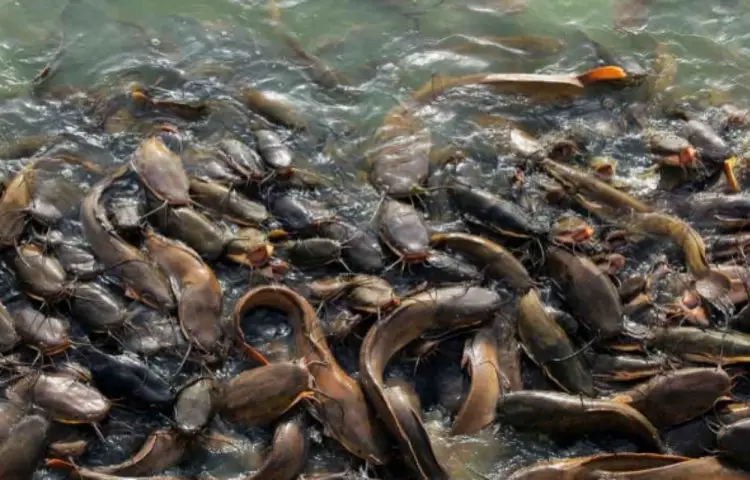Fish Farming: Benefits and How to Get Started Fish Farming
Fish farming generally involves activities such as breeding, rearing, feeding and harvesting of fish species in a safe environment. It contributes significantly to global food security and fisheries also provide employment opportunities. Let us know about the benefits of fish farming and How to Get Started fish farming

Fish farming, also commonly known as aquaculture, involves raising fish for commercial purposes in controlled environments such as ponds, tanks or enclosures. Fish farming generally involves activities such as breeding, rearing, feeding and harvesting of fish species in a safe environment. It contributes significantly to global food security and fisheries also provide employment opportunities. Let us know about the benefits of fish farming and How to Get Started fish farming
Benefits of fish farming
Increase in food production: Fisheries contribute significantly to the increase in food production, which is helpful in meeting the increasing demand for seafood around the world in recent times. It is one of the reliable important sources of protein and essential nutrients for human consumption.
Helpful in employment generation and economic development: Fish farming helps in employment generation and economic development, it creates new employment opportunities in rural and coastal areas, fish farming can be an important industry of aquaculture especially in developing countries. Is. It contributes to developing local economies through employment generation in fish production, processing, marketing and related sectors.
Less pressure on marine fish stocks: Farming fish in controlled environments reduces pressure on marine fish populations, which are often overexploited. It supports sustainable fisheries management and helps conserve biodiversity in natural ecosystems.
Year round availability: Unlike marine fisheries which have seasonal fluctuations, fish farming can be carried out continuously throughout the year. This ensures a continuous supply of fish to markets, reducing dependence on seasonal catches of fish.
Controlled Environment: Fish farming is also able to control environmental variables such as water quality, temperature and food provision. This control helps optimize growth rates, reduce disease outbreaks, and improve overall fish health and productivity.
Efficient use of resources: Aquaculture can be more resource-efficient than traditional livestock farming. Fish convert food into protein more efficiently than land-based animals, requiring less resources such as land and water to produce the same amount of protein.
Diversification of income: For small-scale farmers and coastal communities, fisheries provide an opportunity to diversify income streams and reduce dependence on single crops or fishing activities. This can increase resilience to economic shocks and improve livelihoods.
Potential for Innovation and Technology Adoption: Fish farming offers opportunities for innovation and technological advancements, such as the development of recirculating aquaculture systems (RAS), genetic improvement of fish breeds, and sustainable feed formulations. These innovations can increase productivity and environmental sustainability in the industry.
Environmental Benefits: Well-managed fish farms can have positive environmental impacts, such as habitat restoration, nutrient recycling, and wastewater treatment. Integrated aquaculture systems, such as aquaponics, combine fish farming with plant cultivation, creating symbiotic relationships that reduce waste and resource inputs.
Food Security and Nutrition: Fish farming contributes to global food security by providing a nutritious source of food that is accessible to diverse populations. Fish are rich in essential nutrients such as omega-3 fatty acids, vitamins, and minerals, improving overall dietary diversity and nutrition.
How to Get Started Fish Farming?
Starting a fish farming operation involves several steps. Here's a step-by-step guide to help you get started fish farming:
Research and Planning
- Research different fish species suitable for farming in your area and market demand for those species.
Identify potential markets and customers for your fish products. - Develop a comprehensive business plan outlining your goals, budget, production targets, and marketing strategies.
Site Selection
- Choose a suitable location for your fish farm, considering factors such as access to water, land availability, water quality, and environmental regulations.
- Ensure that the site has adequate space for ponds, tanks, or other production systems, as well as infrastructure for water supply, drainage, and electricity.
Obtain Permits and Licenses
- Check with local authorities to obtain necessary permits and licenses for fish farming operations, including water rights, environmental permits, and aquaculture certifications.
Design and Construction
- Design your fish farm layout based on your chosen production system (ponds, tanks, raceways, etc.).
Construct ponds or tanks using appropriate materials and techniques, ensuring proper water circulation, aeration, and drainage. - Install necessary infrastructure such as pumps, filters, aerators, and fencing to support fish production.
Water Management
- Test water quality parameters such as temperature, pH, dissolved oxygen, and ammonia levels regularly.
- Implement water management practices to maintain optimal conditions for fish health and growth, including regular water exchanges, aeration, and nutrient management.
Stocking and Management
- Purchase high-quality fingerlings or juveniles from reputable hatcheries or suppliers.
- Follow recommended stocking densities and feeding practices for your chosen fish species.
- Monitor fish health, behavior, and growth regularly, and implement disease prevention measures as needed.
- Provide appropriate nutrition and feed management to optimize growth and minimize waste.
Harvesting and Marketing
- Plan for regular harvesting schedules based on market demand and fish growth rates.
- Use appropriate harvesting techniques to minimize stress and ensure product quality.
- Develop marketing strategies to sell your fish products, including direct sales to local markets, restaurants, wholesalers, or online platforms.
Record-Keeping and Evaluation
- Maintain detailed records of production activities, expenses, and revenues to track performance and identify areas for improvement.
- Evaluate your fish farming operation regularly, adjusting management practices and strategies as needed to optimize productivity, profitability, and sustainability.
Continuous Learning and Improvement
- Stay informed about new technologies, research findings, and best practices in fish farming through industry publications, workshops, and networking opportunities.
- Continuously seek feedback from customers, suppliers, and experts to improve your operation and adapt to changing market conditions and environmental factors.
Starting a fish farming business requires careful planning, investment, and dedication, but with proper management and persistence, it can be a rewarding and profitable venture.
F&Q
Q. what is the Fish farming?
Ans : Fish farming generally involves activities such as breeding, rearing, feeding and harvesting of fish species in a safe environment
Q. Is fish farming profitable in UK?
Ans : The fish farming market in the UK is expected to grow at a CAGR of 1.4% from 2024 to 2029 compared to the previous five years.
Q. Which fish farming is most profitable?
Ans: According to the information tilapia, catfish, salmon, prawn, barramundi are considered to be the most profitable fish in fish farming.
Read More: What is DDPI Full Form And Difference Between DDPI and POA

















